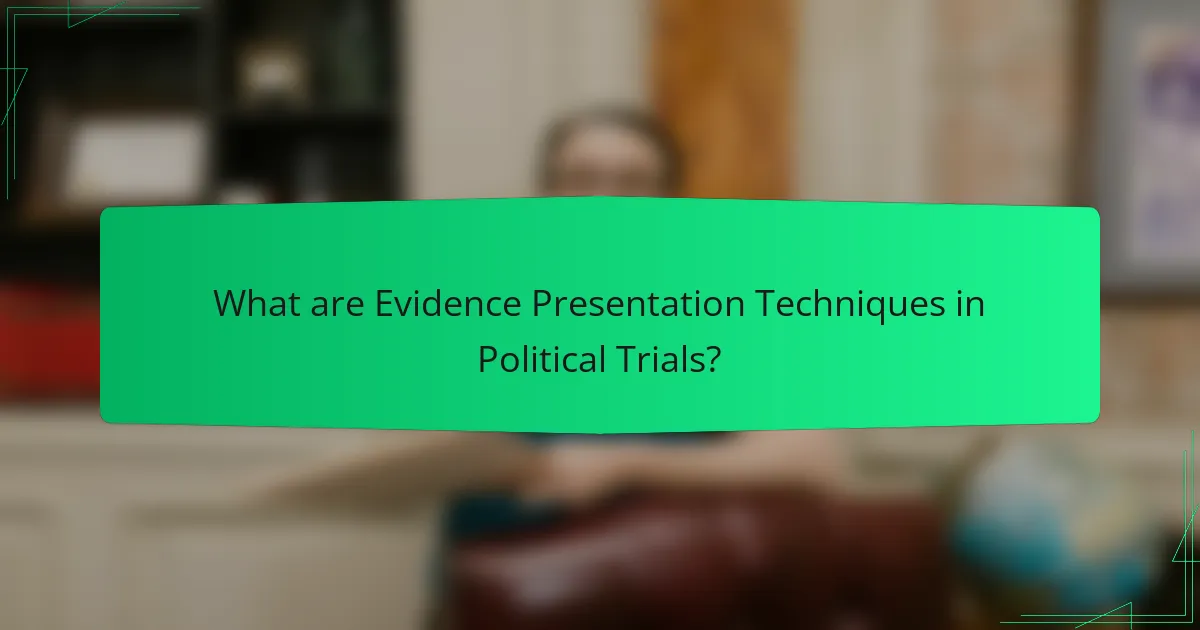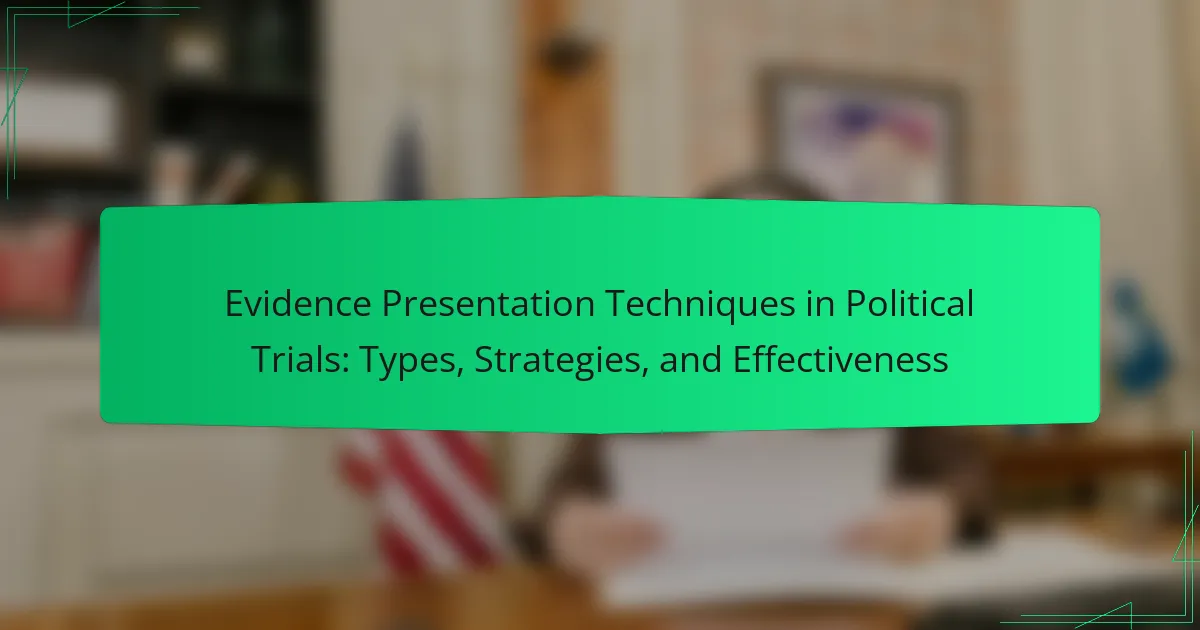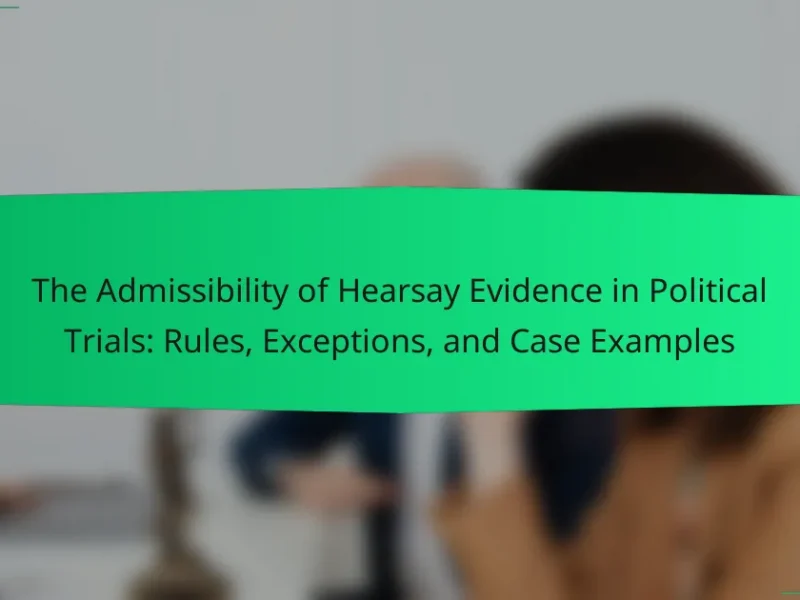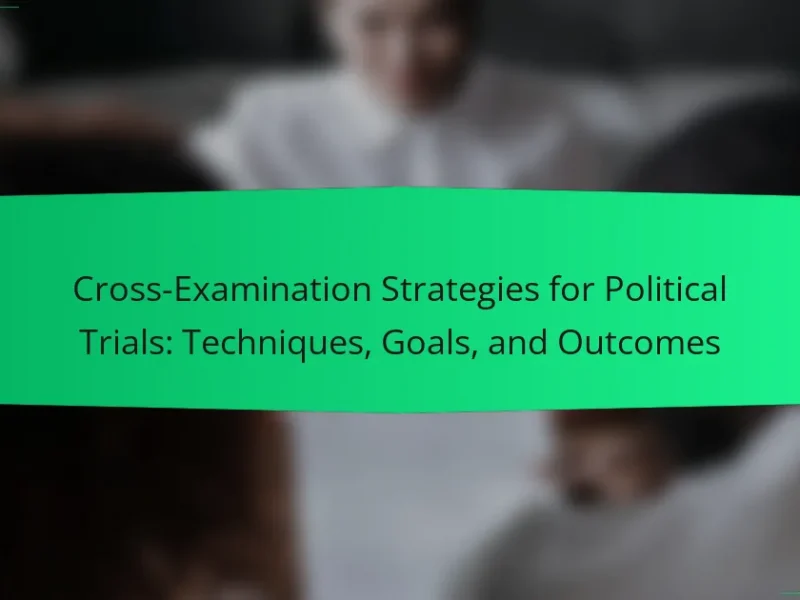Evidence presentation techniques in political trials are essential methods for introducing and displaying evidence effectively to influence judicial outcomes. Key techniques include the use of visual aids, expert testimonies, and structured arguments, each serving to enhance understanding, lend credibility, and present information logically. The article examines various types of evidence presentation strategies and their effectiveness, particularly in high-profile political trials, such as impeachment proceedings, where organized evidence significantly impacts the verdict. Understanding these techniques is crucial for grasping how evidence can sway judges and juries in political contexts.

What are Evidence Presentation Techniques in Political Trials?
Evidence presentation techniques in political trials are methods used to introduce and display evidence effectively. These techniques include visual aids, expert testimonies, and structured arguments. Visual aids can enhance understanding and retention of information. Expert testimonies lend credibility to claims made during the trial. Structured arguments help in logically presenting the evidence. Each technique aims to persuade the judge or jury regarding the validity of the claims. The effectiveness of these techniques can be observed in notable political trials, such as the impeachment proceedings of public officials. In these cases, well-organized evidence presentation significantly impacts the outcomes.
How do these techniques influence trial outcomes?
Evidence presentation techniques significantly influence trial outcomes by shaping juror perceptions and understanding. Effective techniques enhance the clarity and persuasiveness of the evidence presented. For instance, visual aids can help jurors better comprehend complex information. This comprehension can lead to more informed decision-making. Research shows that jurors are more likely to remember and be influenced by evidence presented visually compared to text alone. Additionally, storytelling techniques can create emotional connections, making the evidence more relatable. Such connections may sway jurors’ opinions and lead to favorable verdicts. Overall, the strategic use of evidence presentation techniques is crucial in determining trial outcomes.
What role does clarity play in evidence presentation?
Clarity is essential in evidence presentation. It ensures that the audience comprehensively understands the information being conveyed. Clear evidence reduces the likelihood of misinterpretation. This is particularly important in political trials, where the stakes are high. Research indicates that jurors are more likely to be persuaded by clearly presented evidence. For example, a study by Pennington and Hastie (1993) found that jurors favor clear narratives over complex arguments. Clarity helps in maintaining the attention of the audience, making the evidence more impactful. In summary, clarity enhances comprehension, reduces misinterpretation, and increases persuasive power in evidence presentation.
How does the audience’s perception affect the effectiveness of these techniques?
The audience’s perception significantly influences the effectiveness of evidence presentation techniques in political trials. When the audience perceives the evidence as credible, it enhances the persuasive impact of the arguments presented. Conversely, if the audience doubts the credibility of the evidence, it undermines the overall effectiveness of the techniques. Research shows that jurors’ pre-existing biases can shape their interpretation of evidence. For instance, a study by the National Center for State Courts found that jurors’ perceptions of a defendant’s character can affect their judgment on the evidence presented. This demonstrates that audience perception is crucial in determining how techniques are received and understood.
What types of evidence presentation techniques are commonly used?
Common evidence presentation techniques include visual aids, oral testimony, and written documents. Visual aids often consist of charts, graphs, or videos to clarify complex information. Oral testimony involves witnesses sharing firsthand accounts to support claims. Written documents serve as recorded evidence, such as contracts or official records. These techniques enhance the understanding of the evidence presented. They are frequently employed in political trials to ensure clarity and persuasion. Research indicates that effective use of these techniques can significantly impact juror perception and decision-making.
What is the difference between visual and auditory evidence presentation?
Visual evidence presentation involves the use of images, diagrams, or videos to convey information. It relies on visual stimuli to enhance understanding and retention of information. Auditory evidence presentation, on the other hand, uses sound, such as spoken words or recorded audio, to communicate information. This method engages the auditory senses and can evoke emotional responses.
Research shows that visual information is processed faster than auditory information. Studies indicate that people remember visual content better due to its ability to create mental images. In contrast, auditory presentations can be effective for conveying complex narratives or testimonies. Both methods can complement each other in trials, enhancing the overall effectiveness of evidence presentation.
How do narrative techniques enhance evidence presentation?
Narrative techniques enhance evidence presentation by creating a compelling context for the information. They help to engage the audience emotionally and cognitively. This engagement can lead to increased retention of the evidence presented. For instance, storytelling can frame evidence in a relatable manner. This makes complex data more accessible and understandable. Research shows that narratives can improve persuasion and influence decision-making. A study by Green and Brock (2000) found that narratives can lead to greater belief change compared to non-narrative information. Thus, using narrative techniques effectively can significantly improve the impact of evidence in political trials.
Why are effective evidence presentation techniques crucial in political trials?
Effective evidence presentation techniques are crucial in political trials because they significantly influence the jury’s understanding and decision-making. Clear and organized presentation helps jurors grasp complex information. This clarity can enhance the credibility of the evidence being presented. Studies show that jurors are more likely to retain information when it is delivered effectively. Furthermore, persuasive techniques can sway opinions and highlight key points. In high-stakes political trials, the outcome can affect public perception and policy. Therefore, the manner in which evidence is presented can ultimately determine the trial’s success or failure.
How do these techniques impact jury decision-making?
Evidence presentation techniques significantly impact jury decision-making by influencing perceptions and interpretations of the evidence. Techniques such as visual aids, storytelling, and expert testimonies can enhance jurors’ understanding. For instance, visual aids can clarify complex information, making it more accessible. Storytelling can evoke emotional responses, leading jurors to connect personally with the case. Expert testimonies lend credibility and authority, swaying jurors’ opinions. Research indicates that jurors are more likely to favor cases with well-structured presentations. A study by Penrod and Cutler (1989) found that jurors exposed to effective evidence presentation techniques were more confident in their decisions. Thus, these techniques play a crucial role in shaping jury outcomes.
What are the potential consequences of poor evidence presentation?
Poor evidence presentation can lead to significant negative outcomes in political trials. It may result in misinterpretation of facts. Jurors or judges might draw incorrect conclusions. This can undermine the credibility of the case being presented. Poorly presented evidence can also cause confusion among the audience. It may lead to a lack of trust in the legal process. In some cases, it can result in wrongful convictions or acquittals. Studies show that juries often rely on the clarity of evidence for their decisions. Thus, effective presentation is crucial for achieving just outcomes in trials.
How can one transition from understanding techniques to implementing strategies?
To transition from understanding techniques to implementing strategies, one must apply learned techniques in real scenarios. This involves practicing techniques in controlled environments first. For instance, mock trials can provide a platform for application. Engaging in role-playing exercises enhances practical understanding. Feedback from peers and mentors is crucial for improvement. Analyzing past political trials offers insight into effective strategy implementation. Continuous reflection on outcomes aids in refining future strategies. Research shows that hands-on experience significantly increases retention and application of techniques in real-world contexts.
What strategies enhance the effectiveness of evidence presentation?
Effective evidence presentation strategies include clarity, relevance, and organization. Clear communication ensures that the audience understands the evidence presented. Relevant evidence directly supports the claims being made, enhancing credibility. Organizing evidence logically helps guide the audience through the argument. Visual aids can also enhance retention and understanding of complex information. Engaging storytelling can make evidence more relatable and memorable. Additionally, practicing delivery can improve confidence and impact. Empirical studies show that well-structured presentations lead to better audience comprehension and retention of information.
How does the choice of medium affect the delivery of evidence?
The choice of medium significantly affects the delivery of evidence in political trials. Different mediums, such as video, audio, or written formats, influence how evidence is perceived by juries. For example, visual evidence can enhance emotional engagement and retention. A study by the National Center for State Courts shows that jurors are more likely to remember evidence presented visually. Audio recordings can convey tone and context that written transcripts may lack. The effectiveness of evidence presentation often depends on the audience’s familiarity with the medium. Research indicates that jurors respond differently to complex data presented in graphs versus text. Ultimately, the selected medium shapes the clarity, impact, and persuasiveness of the evidence presented in court.
What are best practices for organizing evidence in a political trial?
Best practices for organizing evidence in a political trial include categorizing evidence by type, relevance, and chronology. Organizing evidence helps streamline the presentation and enhances clarity. Each piece of evidence should be labeled clearly with descriptions and context. This labeling aids in quickly locating specific items during the trial.
Creating a comprehensive index or database can facilitate easy access to evidence. Utilizing visual aids, such as charts or timelines, can help illustrate relationships between pieces of evidence. Ensuring that all evidence is properly authenticated is essential for its admissibility in court.
Regularly reviewing the evidence with the legal team ensures alignment and preparedness. These practices contribute to a more effective and persuasive presentation of the case.
What are the challenges faced in evidence presentation during political trials?
Political trials face several challenges in evidence presentation. One major challenge is the complexity of legal standards for admissibility. These standards can vary significantly between jurisdictions. Another challenge is the potential for bias among jurors or judges. Political trials often attract public attention, influencing perceptions. Additionally, the reliability of evidence can be questioned. For instance, witness credibility may be undermined by political affiliations. The presentation of evidence can also be hindered by procedural delays. These delays can affect the timely delivery of crucial information. Lastly, the emotional weight of political implications can cloud objective analysis. This emotional context may lead to misinterpretation of evidence.
How can biases impact the effectiveness of evidence presentation?
Biases can significantly undermine the effectiveness of evidence presentation. They can lead to selective interpretation of data. This selective interpretation may favor certain narratives over others. For instance, confirmation bias causes individuals to prioritize evidence that supports their pre-existing beliefs. This can distort the overall understanding of the evidence. Additionally, cognitive biases, such as anchoring, can skew perceptions based on initial information. Research shows that biased presentations can influence juror decision-making. A study by the National Center for State Courts found that jurors may misinterpret evidence when influenced by biased framing. Thus, biases can compromise the integrity and clarity of evidence in political trials.
What legal considerations must be taken into account?
Legal considerations in political trials include adhering to evidentiary rules. These rules govern what evidence is admissible in court. Proper chain of custody must be maintained for physical evidence. This ensures that evidence is not tampered with or altered. Witness credibility is also a legal factor; it affects how evidence is perceived. The right to a fair trial must be upheld, ensuring impartiality in proceedings. Jurisdictional issues can arise, impacting the trial’s legal framework. Compliance with constitutional rights is essential, protecting defendants from unfair treatment. Lastly, legal precedents should guide evidence presentation strategies, ensuring consistency with past rulings.
What tips can improve evidence presentation in political trials?
Use clear and concise language to improve evidence presentation in political trials. Simplifying complex information enhances understanding. Visual aids, such as charts and graphs, can make data more accessible. Organizing evidence chronologically helps establish a narrative flow. Highlighting key points ensures that critical information stands out. Engaging storytelling techniques can make evidence more relatable. Practicing effective delivery builds confidence and clarity. Tailoring the presentation to the audience’s knowledge level fosters better engagement.
Evidence presentation techniques in political trials encompass various methods used to effectively introduce and display evidence, including visual aids, expert testimonies, and structured arguments. These techniques play a crucial role in influencing trial outcomes by enhancing juror understanding and shaping perceptions. Clarity, organization, and relevance are key strategies that improve the effectiveness of evidence presentation, while biases and legal considerations must also be navigated carefully. The article explores the types of techniques, their impact on jury decision-making, and best practices for effective evidence organization in politically charged environments.


